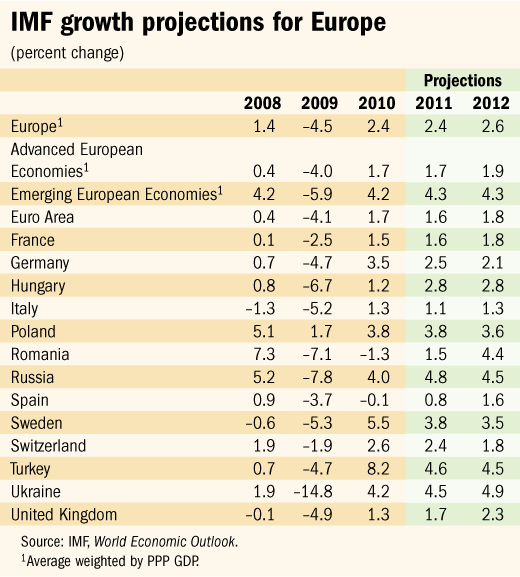
Typical street scene in Santa Ana, El Salvador. (Photo: iStock)
IMF Survey: Strengthening the Recovery for Europe
May 12, 2011
- Growth projections for Europe revised up to 2½ percent for this year and next
- Important challenges remain to overcome sovereign debt problems in the euro area
- Solid recovery under way in emerging Europe but risks should be addressed
At 2.4 percent, economic growth in Europe in 2010 came in a bit stronger than anticipated. For 2011 and 2012, the IMF is predicting growth to continue at a similar pace, according to the IMF’s latest Regional Economic Outlook for Europe (see table).

The European Commission’s headquarters in Brussels, Belgium. Growth is expected to hold steady in Europe but there are risks to the outlook (photo: Newscom)
OUTLOOK FOR EUROPE
Growth is set to be stronger in Europe’s emerging market economies than in its advanced economies. For both parts of the continent, downside risks to the outlook dominate, with the sovereign debt trouble in the euro area being the most pressing challenge facing policymakers.
Substantial measures have already been put in place in the euro area to overcome the crisis. At the national level, strong adjustment policies are being implemented to rebuild and bolster confidence. At the regional level, the crisis management capacity of the European Union (EU) is being strengthened, and the governance framework revamped. Important actions are still required to deal decisively with weak banks across Europe’s advanced economies, and to follow through with implementing the EU-wide reforms that have been agreed in principle.

The risks to the outlook in Europe’s emerging economies will also diminish as financial tensions in the euro area are addressed. Nonetheless, the deep recession of 2009 has left fiscal and financial buffers depleted that now need rebuilding. This is particularly true for public finances, but it also applies to the financial sector, where many banks still have not recovered sufficient ability to lend.
Risks remain to euro area outlook
Growth in the euro area picked up to 1.7 percent in 2010 and is projected to be 1.6 and 1.8 percent in 2011 and 2012. Countries that had steered clear of large current account deficits, excessive debt, and real estate bubbles in the pre-crisis years have managed to rebound quickly from the global crisis thanks to their highly competitive economies. Germany and Sweden in particular have enjoyed buoyant growth.
But countries that built up excessive debt and leverage before the crisis in 2008 are now going through a difficult period of adjustment. Greece, Ireland, and Portugal all had to fall back on financial support from the EU and the IMF. Their near-term growth prospects are clouded, but the support packages now in place include a number of measures designed to cushion the adjustment and restore growth over time.
With the sovereign debt problems contained to just a few, relatively small economies that have limited importance as export markets for the rest of Europe, the overall economic performance of Europe’s advanced economies has remained reasonably strong.
Fixing the financial sector
Financial linkages between countries with sovereign debt troubles and the rest of Europe could potentially pose more risk to the outlook. Banks in the core countries of advanced Europe carry substantial exposure to the euro area periphery on their books, and a shock to confidence could spread quickly throughout Europe.
So far, this financial channel has been muted by a strong policy response involving a number of measures.
•Emergency financing is available through an enhanced European Financial Stability Facility (EFSF), and from 2013 through the successor European Stability Mechanism (ESM).
•EU banking supervision and regulation is strengthened with the establishment of European Supervisory Authorities and the European Systemic Risk Board.
•A reformed Stability and Growth Pact and newly agreed Excessive Imbalance Procedures will bolster the euro area’s ability to prevent future imbalances.
•At the national level, fiscal consolidation, structural and financial sector reforms are underway, which will help underpin market confidence.
Nonetheless, financial spillovers from sovereign debt problems remain a tangible risk. For this reason, it is urgent to implement agreed enhancements to the framework for crisis management in the euro area.
National authorities also need to deal with weak banks in a swift and decisive manner. This is critical to dispel lingering uncertainties about the overall health of the banking sector and the potential fiscal cost of propping them up.
Further recapitalization is also needed to avoid a shortage of credit that could jeopardize the overall recovery. The upcoming EU-wide stress tests provide an opportunity to identify weak banks in a transparent manner. But they will only make a real difference if backed by a program of recapitalization, restructuring, and resolution.
Underpinning the recovery in emerging Europe
Emerging Europe is leaving the deep crisis of 2008-09 behind. In 2010, the region’s economy expanded by 4.2 percent, but growth was still quite uneven. Turkey, Poland, and the European members of the Commonwealth of Independent States (Russia, Belarus, Ukraine and Moldova) forged ahead, but the recovery remains at an early stage in southeastern Europe. For 2011 and 2012, growth in the region is projected to pick up marginally to 4.3 percent and all countries will see positive growth, with fewer disparities among countries.
The main challenge is to protect the recovery from downside risks. The crisis has left deep scars on public finances, banks remain reluctant to lend, and many countries are plagued by high unemployment. Moreover, inflation is picking up across the region.
Fiscal consolidation is needed to rebuild buffers. Countries that came under market pressure have already implemented considerable savings measures, and more consolidation is planned for this year in most countries. Nonetheless, fiscal indicators remain above prudent thresholds in many countries and no longer compare favorably with other emerging and developing countries. This means that repairing public finances is still work in progress. In fast-growing countries, further fiscal consolidation would also help contain inflation.
With few exceptions, bank lending remains subdued in the region. This holds back domestic demand, and delays the reshuffling of capital and labor away from real estate, construction and the financial sector, to manufacturing and other tradable goods.
Such a shift requires investment, and investment requires credit. But banks in the region are still hampered by the non-performing loans on their books, and by the reluctance of foreign parent banks to step up the flow of capital to their local subsidiaries, which make up the bulk of most countries’ banking systems. For this reason, many banks need to switch to a new funding model to revive healthy lending.







